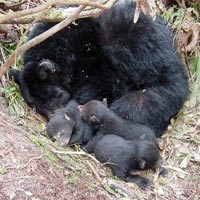|
Although black bears are large, powerful animals who are well equipped to eat meat, they are actually omnivorous eating a variety of plant and animal food items. Bears in the Southern Appalachians primarily feed on grasses and fruit during spring and summer, and acorns, beechnuts and other hard mast in fall. The remainder of their diet consists of insects and other invertebrates, as well as dead animals discovered while foraging. Bears have poor eyesight and depend on a well-developed sense of smell to help locate both food and danger. Unlike members of the cat family, which have the ability to display or hide their claws, bears have large non-retractable claws useful for climbing, gathering food, and defense. Black bears can also stand erect on their hind legs and walk on the soles of their feet rather than just the toes. Black bears are excellent climbers and can scale most trees for food or protection. Surprisingly, despite their short legs and chunky appearance, they can run in bursts of speed up to 30 mph, but only for short distances. They prefer to slowly wander over large areas in search of food, and in the case of males, a mate. 
National Park Service Black bears breed during summer, but due to an uncommon biological adaptation called “delayed embryo implantation,” gestation does not begin until winter hibernation. During this time they can be found in den sites, such as hollow trees, rock cavities or brush piles. Because they do not eat during hibernation, a considerable fat reserve must be built up during summer and fall. Acorns, beechnuts and other hard mast are important food sources, especially for females about to reproduce. If mast crops are poor and the sow does not have the fat reserve necessary to support herself and young, sows may re-absorb the embryo and not give birth that year. Cubs are born in late January while the female is denning. Normally the female will give birth to two cubs, but litters may vary from one to five cubs. At birth, each cub is extremely small, weighing between 8 to 12 ounces. Because the cubs will nurse almost continuously they will grow rapidly and usually weigh 5 to 7 pounds when they leave the ten in late march or early April. The young will cubs stay with their mother throughout the summer and den with her again the following winter. By the time the cubs are 1 ½ years old, they leave the mother and the sow is then free to breed again. Most females reach sexual maturity between 2 ½ and 3 ½ years. While they are primarily active at night, black bears are sometimes seen during daylight hours. Most sightings are reported between late spring and mid-summer, the peak period for young males to leave their family units and search for home territories of their own. It is extremely rare for black bears to be aggressive toward humans. They are shy, secretive animals that do not socialize with each other, except in individual family units or during the breeding season. Normally, they will hide or run away to avoid any contact with humans. Unfortunately, providing food to bears can change their behavior and draw them close to humans. |
Last updated: April 14, 2015
